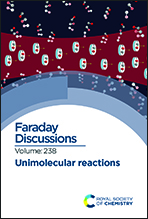Spiers Memorial Lecture: Theory of unimolecular reactions
Abstract
One hundred years ago, at an earlier Faraday Discussion meeting, Lindemann presented a mechanism that provides the foundation for contemplating the pressure dependence of unimolecular reactions. Since that time, our ability to model and predict the kinetics of such reactions has grown in leaps and bounds through the synergy of ever more sophisticated experimental studies with increasingly high level theoretical analyses. This review begins with a brief historical overview of the progress from the Lindemann mechanism to the master equation, which now provides the cornerstone for most theoretical analyses. The current status of ab initio transition state theory based implementations of the master equation is then reviewed, beginning with a discussion of the energy resolved chemical conversion rates, followed by a review of the pressure dependence of the thermal kinetics. The latter discussion focusses on the collisional energy and angular momentum transfer rates as well as the complexities of non-thermal effects and of multiple-well multiple-channel reactions. The synergy with recent state-of-the-art experiments is used to motivate these discussions. Attempts to automate the calculations are also briefly reviewed. Throughout the discussion, we provide our perspective on current understanding and continuing challenges and opportunities. One key challenge relates to the coupling of sequences of reactions, which frequently leads to deviations from the classic presumption of thermal reactants.

- This article is part of the themed collections: The Spiers Memorial Lectures and Unimolecular reactions


 Please wait while we load your content...
Please wait while we load your content...
